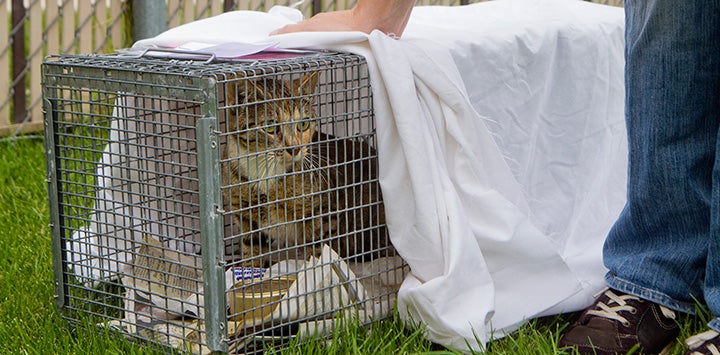
Community Cat Programs Training Playbook
Introduction
Across the nation, cats are the most at-risk population of animals in shelters. While dog intake is higher than cat intake, more than twice as many cats are dying in shelters. About 50% of cats who end up in shelters are community (aka unowned, stray, feral) cats and without proper programming, shelters struggle to find positive outcomes for many of these cats.
The traditional way to manage populations of outdoor cats (impoundment and death by lethal injection) has proven to be ineffective at curtailing their numbers and damages relationships with the community members that care for these cats. Nationwide, year after year, we see shelters inundated with community cats and kittens, so we know that what we have been doing isn’t working. Lost pet cats are also more likely to find their way home if their community has a CCP than through impoundment at the shelter. The national return-to-owner rate for cats in shelters is less than 3%.
Community cat programs (CCPs) are a critical lifesaving option. CCPs are effective at reducing the numbers of these cats in the community, reducing shelter admissions and therefore shelter deaths, saving taxpayers money and providing a public health benefit to the community. In such programs, free-roaming outdoor cats deemed healthy enough to qualify for the program are sterilized, vaccinated and returned to their original location.
Program Overview
Community cat programs enable shelters to provide community cats with a live outcome while supporting community engagement. After being spayed or neutered and vaccinated, the cats are returned to their original location, where they can continue to thrive and live out their lives. CCPs reduce the existing population over time, reduce the spread of disease and mitigate many common complaints associated with un-altered cats.
There are several names for community cat programs:
- TNR (trap-neuter-return)
- TNVR (trap-neuter-vaccinate-return)
- SNR (shelter-neuter-return)
- RTF (return-to-field)
Note: Although only one of the above includes the word “vaccinate,” vaccinating community cats is best practice. All Best Friends community cat programs administer the FVRCP and rabies vaccinations.
If your department faces obstacles such as ordinances that prohibit you from implementing a CCP, efforts to review (and change if necessary) those ordinances should be a primary focus. Be aware that making these changes is often a lengthy process, and municipalities can be resistant to change. Creating a proposal for a pilot program is one way to introduce a CCP in the interim.
Program Composition
The following describes workforce needs, internal and/or external resources, and any other additional steps that should be taken into consideration for successful program implementation. Necessary components of CCPs include:
- Local ordinances that support or, at the very least, do not work against community cat programs (pilot programs are an exception)
- Agency-wide training on implementing/operating the program and mitigating nuisance complaints in the community
- Team lead or point person for the program (and contact information being readily available)
- Trained staff and volunteer TNR trappers/transporters
- Collaborative relationship with existing TNR programs and cat caregivers in the community
- Standard operating procedures, liability waivers, program outline and expectations
- Traps and other necessary supplies (e.g., food, towels, sheets)
- Partnership agreements with local supporting clinics (if surgeries are outsourced)
- Community engagement and communication strategies (for introduction of the program, ongoing efforts and conflict mitigation)
- Printed resources about the program
- Cat deterrent information and (if possible) a loan-out program
It’s also important to have full transparency about the program in the community. This involves the following:
- Let the community know what you are doing, why you are doing it, and what you need from them. Being engaged with your community will lead to trust and confidence in your lifesaving efforts. Silence opens the door for misinformation to be spread (and believed).
- Let finders of stray cats know about your SNR program and inform them that the cats eligible for SNR will be released back into the community. Ensure this communication is happening consistently, and at all levels of the organization.
- Be prepared to inform the community of the proven success of CCPs and the lifesaving benefits of them vs. the traditional approach of trap-and-kill.
- Be upfront and completely honest about your community cat program and be prepared with facts and data when asked about your lifesaving success.
- Listen to members of the community, including those who don’t want community cats on their property or consider them a nuisance. Acknowledge their concerns and address the issues with compassion, information and resources (e.g., humane deterrents).
Read more about the benefits of full transparency.
Sample Procedure and Program Information Documents
Now that you have a general understanding of community cat programs, the following documents may act as templates as you implement these strategies and programs at your organization. Keep in mind that there is no exact or perfect form of implementation. Using the considerations and program composition notes above, you should use the following only as guidelines or building blocks when creating your own standard operating procedures or documents (both internal and public). If you need further assistance or clarification, please reach out to your regional strategist, regional director, or the Best Friends national shelter support team at team2025@bestfriends.org
- Best Friends Animal Society’s Community Cat Programs Handbook
- Best Friends Animal Society’s Humane Animal Control Manual
- Best Friends Animal Society’s TNR Action Toolkit
- The Humane Society of the United States’ Pets for Life Guidebook
- Alley Cat Allies’ Guide to TNR and Colony Care
- Neighborhood Cats’ Overview of a TNR Project
- Neighborhood Cats’ TNR Handbook and comprehensive list of resources for download
- The Jackson Galaxy Project’s comprehensive list of TNR resources
- Best Friends Animal Society’s Working Cat Program in Atlanta and Los Angeles
- Alley Cat Allies’ Targeted Trapping information
Updated May 2022
If you found this playbook helpful, check out our full catalog of handbooks, manuals, and playbooks.